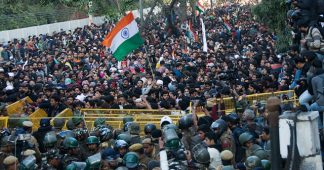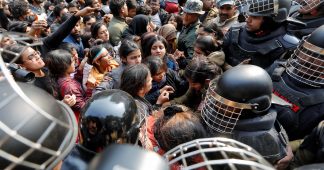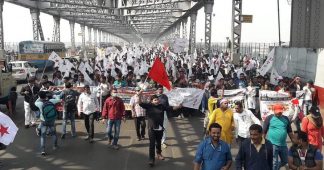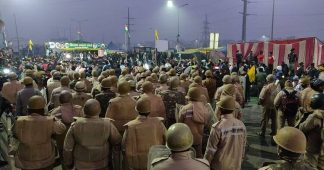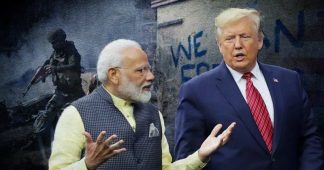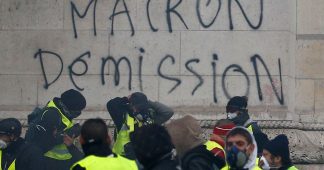Victims and survivors of the five-days long violence by mobs led allegedly by the far-right leaders of the BJP recollected their horrors at a press conference organized by the Communist Party of India (Marxist)
by Pavan Kulkarni
Mar. 2, 2021
Photo : Newsclick
A year after the anti-Muslim pogrom perpetrated by far-right mobs in the northeast of India’s capital city, victims recounted their harrowing memories of violence at a press conference organized on February 23 by the Delhi state committee of the Communist Party of India (Marxist) (CPI(M)).
53 people — over three-quarters of whom were Muslims — were killed in this violence, which went on for five days starting from February 23, 2020. Hundreds were injured, many of whom are now left with permanent disabilities.
Victims recollected how the police not only failed to stop the violence, but actively connived with the perpetrators — an allegation substantiated by numerous videos and eyewitness accounts of police firing bullets and tear-gas at the very victims under attack by the mobs. Atrocities by the police of already injured victims is also well-documented.
Hundreds of houses, shops, hotels and other means of livelihood, mostly used by Muslims, were identified and burnt down. The small sums of monetary compensation paid out by the Delhi government led by the populist AAP has done little to rehabilitate the livelihoods, especially of those families which lost all their earning members to the violence.
The protests against the Citizenship (Amendment) Act
This violence was unleashed in the backdrop of protests against the Citizenship (Amendment) Act (CAA) passed in December 2019. It is widely feared that the net effect of this act, enacted in conjunction with the country-wide implementation of the National Register of Citizens (NRC), will jeopardize the citizenship rights of Indian Muslims, especially the poor who often do not possess all the papers to ‘prove’ their citizenship.
The protest movement against the CAA-NRC constituted the first major popular challenge to the BJP, which subscribes to the Hindu-supremacist ideology espoused by its parent body, the Rashtriya Swayamsevak Sangh (RSS), one of the world’s biggest paramilitary organizations, formed in 1925. Its ideological leaders, who explicitly drew inspiration from Fascist Italy and Nazi Germany, time and again clarified their position that Muslims — or for that matter followers of any religion whose main holy sites are located outside of India — should not be entitled to equal citizenship rights. Modi himself has been a long-time member of the RSS, which has groomed him from his younger days.
What began as protests and rallies by students against this agenda, evolved into numerous sit-in protests, many of which were led by women, across the country, after the Delhi Police unleashed brutal violence against students, barging into the campus of Jamia Millia Islamia, one of the India’s most reputed universities, and assaulting even those studying in the library.
Election campaign against protests
By the last week of January 2020, there were roughly 40 such sit-ins across the country. 10 of those, including the first and the largest one in Shaheen Bagh, were in the capital city which was ticking closer to the legislative assembly elections scheduled for February 8.
The BJP campaigned almost exclusively on a single point agenda of punishing the protest movement. “Shoot the traitors!” — which is what the protesters were deemed — was a common slogan raised at all its election rallies. Speaking from electoral platforms, senior leaders of the party, including a union minister, made wild allegations ranging from protesters receiving funds from Pakistan to protesters planning to rape Hindu women.
However, the BJP lost the election, while AAP managed to retain the Delhi government by skirting this highly polarizing subject and sticking to its talking points around the issues of water, electricity, schools etc.
Defeat in the regional election, however, did not put an end to the vicious campaign against the protest movement. Addressing a mob on February 23 in the presence of the Deputy Commissioner of Police (DCP) for northeast, where eight of Delhi’s 10 protest sites were concentrated, Kapil Mishra, a senior BJP leader in Delhi, gave an ultimatum that they would take the matters into their own hands if the police does not vacate these sit-ins.
Beginning of the violence
Shouting ‘Long live Kapil Mishra,’ ‘Long live Delhi police,’ ‘Shoot the traitors’ and other communally provocative slogans, a mob of about 200-250 had gathered at a square in the Khajuri Khas area, dangerously close to three women-led anti-CAA protest sites.
Mohammed Mumtaz stepped out of his restaurant to check if he had to shutter down his business and leave for safety. But it was too late. Within minutes of his returning, the mob had begun pelting stones at his restaurant.
“I was hiding under the counter to protect myself, but then a group of 20-25 people held me at gun-point and looted all my cash,” he recollected at the press-conference exactly a year after the incident. Mumtaz knew them by their names. Among them was also the person from whom his family had bought the land to settle down in this area.
“You’ve known me since I was a child. You’ve often dined at my restaurant,” Mumtaz pleaded for mercy, only to be abused with slurs targeting his religion and threatened with murder. He managed to somehow wriggle himself free and make a run but from the backdoor of his restaurant which was then set on fire.
At the Dayalpur police station, the police refused to file an FIR, if his complaint included the names of the attackers. “Give a complaint without names, if you want compensation,” he was told. On his way back home, only 200 meters from his burning restaurant, Mumtaz was terrorized by what he saw at the corner of the lane.
Role of BJP leaders
Mohan Singh Bisht, a Member of the Legislative Assembly (MLA) from the BJP, he claims, was telling a mob following him, “you’ve only burnt the business of these” Muslims, referring to the community with slur. “Now kill them all one by one.”
Mumtaz was overwhelmed with fear, heightened by a sense of incredulity. “Because I had worked under Bisht as a cadre of the BJP. I had personally set up an office for him at one of my properties,” he said.
The following morning, at around 8:30 am, when he was collecting the burnt items lined up outside his restaurant in presence of a police team, he claims to have seen one policeman hand a phone to the Station House Officer, saying Satya Pal Singh, a BJP member of parliament (MP) was on line. “Don’t worry, sir, none of these Muslims will survive today,” he heard the SHO say.
Within hours of this call, violent mobs had descended on all the sit-ins in this area.The police, vastly outnumbered, not only permitted the mobs to attack the women at the sit-in, but even took active part, as shown by many accounts over the month.
Protesters who were attacked recollect how the action of the mob and the police were coordinated. Rounds of tear gas fired by the police would blind the protesters on whom the right wing mob were pelting stones. The tents in which these sit-in demonstrations were being staged were set on fire.
Injured youngsters tortured by police
On hearing about the attack, Wasim, whose mother was a part of the sit-in in Kardampuri, rushed to the site to look for her. He was caught, along with four others, and beaten up by a mob. The police, who then took them into custody, were filmed torturing the already injured.
The brutal footage, widely circulated on social media, showed the bleeding five young men, lying over each other in contorted positions, being forced by the police to sing the national anthem. One of them later succumbed to his injuries.
“The police have left us with no more faith in the system,” Wasim’s father, Atulla Khan, said at the press conference. “You’ve all seen how they were tortured. It has been one year now and no action has been initiated against these policemen.” He said his complaint is not being registered and the people helping him are being harassed by the police.
The violence did not end with the dispersal of all the protest sites in northeast Delhi. It was the beginning of a five-day long siege on the Muslim-majority areas which supported the protests. Residents mobilized in defense and fought back to keep the mob from entering inside the residential colonies.
However, the mobs had managed to barge into the colonies by the end of the day, roaming the lanes with chants of “Jai Shree Ram (Hail Lord Ram).” In Bhagirati Vihar, Mallika, then 30-years-old, was among the Muslim tenants who were advised by their Hindu landlord to stay indoors.
Beaten unconscious, thrown into fire, and dumped in a drain
By the morning of February 25, the mobs started pelting stones at the building. They left at the intervention of the landlord, whose tenants also included Hindus. However they barged into their lanes again in greater numbers by the evening and began threatening to burn down the homes of Muslims if the menfolk did not step outside.
Getting a glimpse of the mob from her house on the third floor, Mallika hurriedly hid her husband, 34-year-old Musharraf, inside a bed box, buried him under a pile of clothes and locked the box. The mob which barged into her house, broke open the lock, shoved iron rods through the clothes to check. When Musharraf screamed in pain as the rod hit his body, he was dragged out and beaten unconscious in front of his wife and two young children.
“They dragged him out of the house while continuing with the beating. He was then thrown into fire and his body was finally dumped into the open drain,” Mallika recollected at the press conference, breaking down in tears.
Mohammed Wakeel, did not have any eyes to shed tears as he narrated his ordeal. A patch of pinkish skin now covers the area where his eyes were until that ill-fated day last year, when a rampaging mob entered Shiv Vihar.
On seeing the residents flee, Wakeel shuttered his shop on the ground floor and hurried to the terrace where he was spotted by the mob, which hurled acid bottles at his face and torched his shop below.
It was only the next day, on February 26, that he received medical attention at a hospital where he was admitted for one month. He has been blind for a year now, but vivid and graphic visual memories of the violence remain alive in his mind as he narrated the details of the attack.
“A person like Wakeel, in this condition, has been forced to come here before you to narrate his story because he has been denied justice. What you have heard here is the testimony of seven people. There are hundreds of such families,” said Brinda Karat, a politburo member of the CPI(M).
State complicity?
Details of the extent of losses suffered and the complicity of the ruling BJP are elaborated in a report released by the party in November 2020. It is based on interviews with over 400 affected families, eyewitness accounts, police responses to court petitions and news reports.
“It is not possible that in the capital of India, the city should burn for five days under the direct self-proclaimed monitoring of the home minister and the home ministry,” Karat argued.
Between February 23 and February 26, a total of 13,200 distress calls were made to the police, most of which went unattended. Despite the many intelligence alerts about the risk of outbreak of violence and the need to increase deployment, on February 23, when 700 distress calls were made, only 1,393 personnel were deployed.
The next day, when 13 people were killed, “the home ministry of India chose to deploy only 6 more police personnel,” she added. It was only on the evening that day that Section 144 (curfew orders) was imposed. However, little effort was made to enforce Section 144 in order to stop the rampaging mobs.
On February 25, when 29 people were killed, the police deployment was raised only to 4,291. This fell way short of what was needed, given that 7,500 distress calls were made that day alone.
Kapil Mishra, whose hate speech initiated the violence, had said in an interview only a day before the press conference that he is proud of what he had done, and would do it again if he had to.
On the other hand, the very women who were attacked in the protest sites are being interrogated, harassed and jailed. The anti-CAA activists who had spearheaded the peaceful protests have been arrested under draconian anti-terror laws.
“There is a deliberate subversion of justice.. to conceal the role of the BJP leaders,” Karat said, reiterating the CPI(M)’s demand for an independent enquiry headed by a retired high court judge with an undisputed record of impartiality.
Published at peoplesdispatch.org
